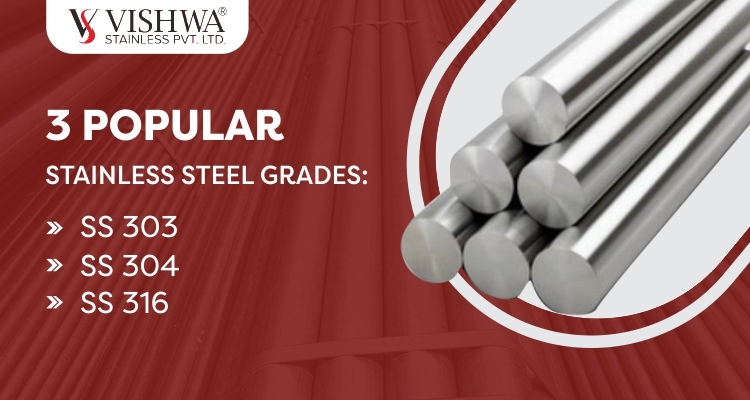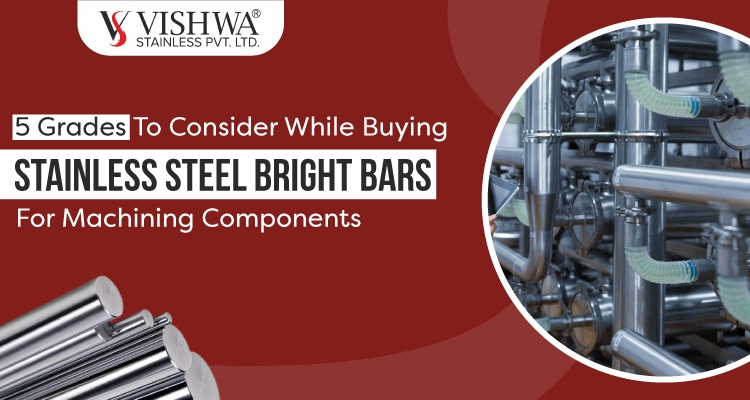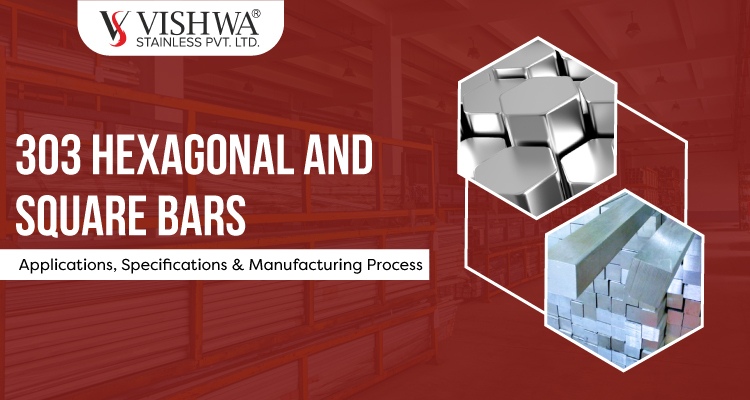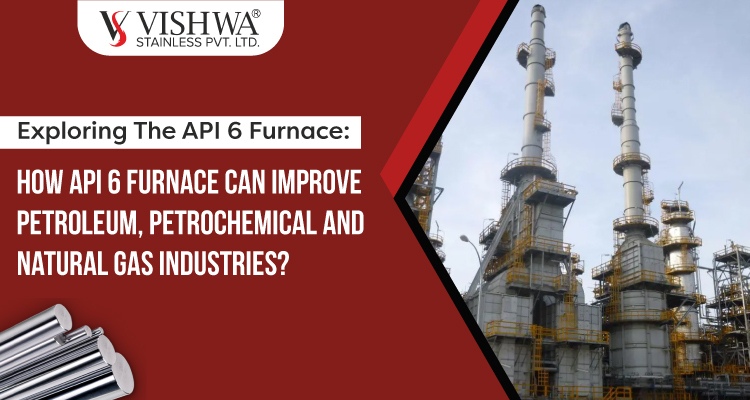Stainless steel refers to the family of corrosion-resistant and heat resistant, one of its primary features is the consistency of 10.5% of chromium that profits stainless steel with premium resistance to corrosion in comparison to other classes of steel. Its primary composition of iron, carbon, and the addition of several alloys but chromium is the monarch of all. The term “grade” in stainless steel stands for quality, durability, and temperature resistance. Here we will go through steel classifications and the three most popular grades of stainless steel.
What are the Classifications and Main Grades of Stainless Steel?
Austenitic Stainless Steel:
Austenitic stainless steels comprise the most common type of stainless steel, containing elevated levels of chromium, molybdenum, and nickel. They are particularly versatile and are renowned for displaying excellent strength and malleability.
The term “austenitic” refers to a crystalline structure that reflects its unique characteristics of strength and malleability. Consists of iron mixed with a small amount of chromium and carbon. Chromium is the reason for its corrosion-inhibiting properties
Ferritic Stainless Steel:
This stainless steel usually consists of low carbon consistency of not more than 0.1% and chromium measurement between 10.5% and 30%, these alloys are magnetic and primarily chosen for their resistance to temperature oxidation and stress corrosion cracking.
The second most widely used type of stainless steel after austenitic stainless steel, containing a low amount of carbon and a high amount of chromium and a very little nickel, well-known for their corrosion-resistance and magnetic properties, they can be cold worked and softened through annealing.
Duplex Stainless Steel:
Duplex stainless steel is a blend of austenitic with the ferritic, resulting in a stronger metal than individually both: this higher strength can lead to considerable weight reductions. Even in demanding environments, it secures excellent corrosion that’s what makes duplex stainless steel ideal steel for marine applications.
Martensitic Stainless Steel:
Martensitic stainless steel can be solidified to a larger degree, its structure is similar to ferritic stainless steel but with a high carbon addition (up to 1.2%), especially useful for creating medical tools and surgical instruments.
Developed to satisfy requirements for hardness, high strength, corrosion, and wear resistance with effective steel content, they also act as ferromagnetic which means they can retrain their magnetic properties after the magnetic field is withdrawn. Unlike ferritic and austenitic stainless steels, they can be hardened by heat treatment but due to lower chromium, martensitic stainless steels are not as corrosion resistant.
What is Stainless Steel Grade SS 303?
Stainless Steel Grade 1.4305 is popularly known as grade SS 303 which stands as the most readily machinable of all the austenitic alloy grades of stainless steel that enables improves machining due to the presence of Sulphur in the steel composition, benefits in corrosion reduction, but a slight toughness lowering, still reflects excellent. Also fairly resistant to general atmospheric corrosion, foodstuffs, sterilizing solutions, dyestuffs, and most organic chemicals. Read below to know the specifications of SS 303 Grade.
Specifications and Properties of Stainless Steel Grade SS 303:
Machinability:
High machining rates get obtained even at the annealed condition.
Hot Working:
Forging that involves hot working should occur after uniform heating to 1149-1260°C. Safe side for maximum corrosion resistance fabricated components should be cooled rapidly.
Corrosion Resistance:
The addition of sulfur to the compositions makes grade SS 303 an ideal aspect for corrosion resistance that remains excellent in a mild environment. Dolefully, unsuitable for marine environment usage.
Heat Resistance:
303 stainless steel has satisfactory resistance to oxidation when temperatures are 760°C, and can also continue the same service even temperatures exposure up to 870°C.
Fabrication:
Should be done only with tools dedicated to stainless steel materials, and must be thoroughly cleaned before use. To avoid cross-contamination of stainless steel these precautions are mandatory.
What is Stainless Steel Grade SS 304?
304 stainless steel is commonly viewed as the most standard austenitic stainless steel also known as 1.4301 and 1.4307 respectively. With the perk of containing high nickel content that is usually between 8 and 10.5 percent by weight and a high amount of chromium at approximately 18 to 20 percent by weight. The dominant grade is used in applications like sinks and saucepans and also in heavy gauge components for improved weldability.
Specifications and Properties of Stainless Steel Grade SS 304:
Machinability:
Benefits with high strength and work hardening rate.
Hot Working:
Hot-working operations should be followed by annealing at an initial forging temperature of 1150°C to 1260°C.
Corrosion Resistance:
Has exceptional corrosion resistance in a wide variety of environments and when in contact with different corrosive media. Pitting and crevice corrosion can occur in environments containing chlorides. Stress corrosion cracking can occur at temperatures over 60°C.
Heat Resistance:
It performs exceptionally even in an oxidizing environment with an intermittent service temperature up to 870°C and in continuous service to 925°C. However, continuous use at 425-860°C is not recommended if corrosion resistance in water is required.
Fabrication:
Tooling and work surfaces must be thoroughly cleaned before use, if precautions would not taken perfectly, easily corroded metals may discolor the surface of the fabricated product.
What is Stainless Steel Grade SS 316?
Type 316 stainless steel includes chromium-nickel stainless, and molybdenum-bearing it as greater resistance to chemical attack than 304, with advantages of heat-resisting steel and superior corrosion resistance as compared to other chromium-nickel steels, even when exposed to varies of chemical corrodents such as seawater, brine solutions. Type 316 is durable, easy to fabricate, clean, weld, and finish, and considerably more resistant to solutions of sulfuric acid, chlorides, bromides, iodides, and fatty acids at high temperatures.
To Stainless Steel Chemical Composition
Specifications and Properties of Stainless Steel Grade SS 316:
Machinability:
Alloy SS 316 is subject to work hardening during deformation and is subject to chip breaking, best machining results are achieved with slower speeds, heavier feeds, and sharp tooling.
Hot Working:
Working temperatures of 927–1204°C are recommended for most hot working processes. For maximum corrosion resistance, the material should be annealed at 1038°C minimum and water quenched or rapidly cooled by other means after hot working.
Corrosion Resistance:
Due to the addition of molybdenum, grade 316 stainless steel is more corrosion resistant than similar alloys, by reducing pitting from chemical environments it entitles grade 316 stainless steel to be highly used in acid and caustic environments that would otherwise eat away at the metal.
Heat Resistance:
The temperature tolerance of grade 316 stainless steel is close to that of grade 304, the melting range of 316 SS is 2500 °F – 2550 °F (1371 °C – 1399 °C), roughly 50 to 100 degrees Fahrenheit lower than the melting point of grade 304 stainless.
Fabrication:
Fabrication of all stainless steel should be done only with tools dedicated to stainless steel materials, and need to take precautions of hygiene and sanitation.
Conclusion
Using any of Stainless Steel Grades: SS 303, SS 304 or SS 316 can level up the product benefits with its key features of high strength, corrosion-resistant, heat resistance and can also be ideal for steel long-life durability.
Vishwa Stainless Pvt. Ltd. is a global leading manufacturer and exporter. All products are customized according to our client’s requirements, equipped with the latest technology with the minute precision to produce stainless steel products such as stainless steel bars with SS 303, SS 304, and SS 316 grades, SS Bright Round Bars, SS Hexagonal Bars, SS Wires, SS Bright Square Bars, Precision SS Bright Bars, SS Cold Drawn bars and many more. Get a Free Quote from us Today.
Read More
303 Austenitic Stainless Steel Bright Bars – The Definitive Guide
Differentiation Between 304 vs 316 Stainless Steel Grade – The Definitive Guide
5 Fast Moving Applications of Stainless Steel Bright Bars-An Informative Guide




